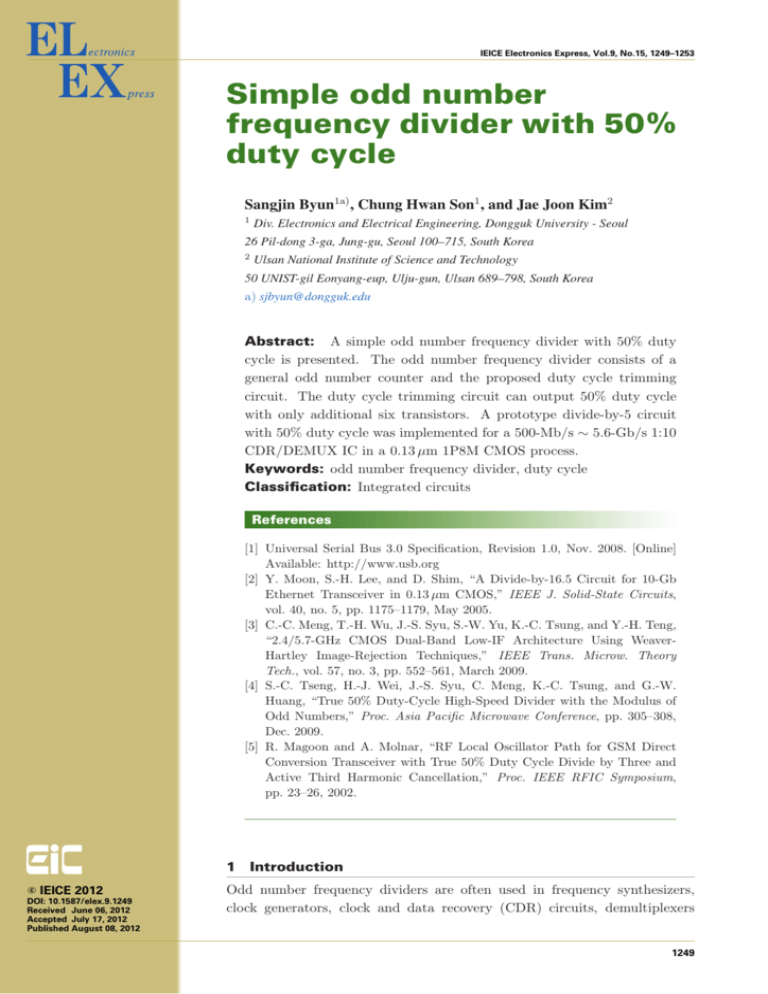Simple odd number frequency divider with 50% duty cycle
advertisement

IEICE Electronics Express, Vol.9, No.15, 1249–1253 Simple odd number frequency divider with 50% duty cycle Sangjin Byun1a) , Chung Hwan Son1 , and Jae Joon Kim2 1 Div. Electronics and Electrical Engineering, Dongguk University - Seoul 26 Pil-dong 3-ga, Jung-gu, Seoul 100–715, South Korea 2 Ulsan National Institute of Science and Technology 50 UNIST-gil Eonyang-eup, Ulju-gun, Ulsan 689–798, South Korea a) sjbyun@dongguk.edu Abstract: A simple odd number frequency divider with 50% duty cycle is presented. The odd number frequency divider consists of a general odd number counter and the proposed duty cycle trimming circuit. The duty cycle trimming circuit can output 50% duty cycle with only additional six transistors. A prototype divide-by-5 circuit with 50% duty cycle was implemented for a 500-Mb/s ∼ 5.6-Gb/s 1:10 CDR/DEMUX IC in a 0.13 µm 1P8M CMOS process. Keywords: odd number frequency divider, duty cycle Classification: Integrated circuits References [1] Universal Serial Bus 3.0 Specification, Revision 1.0, Nov. 2008. [Online] Available: http://www.usb.org [2] Y. Moon, S.-H. Lee, and D. Shim, “A Divide-by-16.5 Circuit for 10-Gb Ethernet Transceiver in 0.13 µm CMOS,” IEEE J. Solid-State Circuits, vol. 40, no. 5, pp. 1175–1179, May 2005. [3] C.-C. Meng, T.-H. Wu, J.-S. Syu, S.-W. Yu, K.-C. Tsung, and Y.-H. Teng, “2.4/5.7-GHz CMOS Dual-Band Low-IF Architecture Using WeaverHartley Image-Rejection Techniques,” IEEE Trans. Microw. Theory Tech., vol. 57, no. 3, pp. 552–561, March 2009. [4] S.-C. Tseng, H.-J. Wei, J.-S. Syu, C. Meng, K.-C. Tsung, and G.-W. Huang, “True 50% Duty-Cycle High-Speed Divider with the Modulus of Odd Numbers,” Proc. Asia Pacific Microwave Conference, pp. 305–308, Dec. 2009. [5] R. Magoon and A. Molnar, “RF Local Oscillator Path for GSM Direct Conversion Transceiver with True 50% Duty Cycle Divide by Three and Active Third Harmonic Cancellation,” Proc. IEEE RFIC Symposium, pp. 23–26, 2002. 1 c IEICE 2012 DOI: 10.1587/elex.9.1249 Received June 06, 2012 Accepted July 17, 2012 Published August 08, 2012 Introduction Odd number frequency dividers are often used in frequency synthesizers, clock generators, clock and data recovery (CDR) circuits, demultiplexers 1249 IEICE Electronics Express, Vol.9, No.15, 1249–1253 (DEMUXs), etc [1, 2, 3]. For an example, a 2:10 DEMUX of a high speed serial interface receiver may need a divide-by-5 circuit for output clock signal generation. Although odd number frequency dividers do not have 50% duty cycle, they are sometimes required to have exact 50% duty cycle. It is because both of rising and falling edges of the divided clock signal can be used for efficient high speed operation. To obtain 50% duty cycle, special types of latches or flipflops have been generally used for odd number frequency dividers [2, 3, 4, 5]. A negative level sensitive latch was used in [2] and a current switchable D flipflop (DFF) was used in [3, 4, 5] for dual edge triggering operation in odd number frequency dividers. However, those special latches and flipflops require more circuit complexity and are not appropriate when a rail-to-rail signal swing is needed. In this paper, we present a simple full swing odd number frequency divider with 50% duty cycle. The presented odd number frequency divider consists of a general odd number counter and the proposed duty cycle trimming circuit. For the odd number counter, single edge triggered CMOS DFFs are used. The duty cycle trimming circuit can output 50% duty cycle with only additional six transistors: i.e. one NMOS transistor, one PMOS transistor and a pair of cross-coupled inverters. 2 c IEICE 2012 DOI: 10.1587/elex.9.1249 Received June 06, 2012 Accepted July 17, 2012 Published August 08, 2012 Proposed duty cycle trimming circuit Fig. 1 shows the proposed odd number frequency divider with the division ratio of 5. It consists of a divide-by-5 circuit and a new duty cycle trimming circuit. The divide-by-5 circuit contains three rising-edge triggered DFFs and one NAND gate. The duty cycle of the divider’s output clock signal, X, is not 50% but 60% because all the DFFs of the divide-by-5 circuit are triggered by the rising edge of the input clock signal, CLKIN . So, the proposed duty cycle trimming circuit is added after this divider. The duty cycle trimming circuit consists of two transistors, M1 and M2, and a pair of cross-coupled inverters, INV1 and INV2 , as shown in Fig. 1. M1 and M2 are an NMOS transistor and a PMOS transistor, of which gate, source and drain terminals are connected to each other. Because both gates of M1 and M2 are driven by the same CLKIN , M1 can be turned on when CLKIN =1 and M2 can be turned on when CLKIN =0. Between the cross-coupled inverters, INV1 and INV2 , the transistor sizes of INV2 are designed much smaller than those of INV1 and other transistors of M1, M2, and DFF1 ∼ DFF3 . To explain the operation of the proposed duty cycle trimming circuit, we derived the truth table of this duty cycle trimming circuit as shown in Fig. 2 (a). First, let’s assume CLKIN =0 and X=0. When CLKIN =0, M1 is turned off and M2 can be turned on. But X=0 makes the turn-on resistance of M2 very high and the cross-coupled inverters hold their values at Y and CLKOUT . Second, let’s assume CLKIN =0 and X=1. Now M2 is turned on with the low turn-on resistance and Y equals X regardless of its previous value, i.e. Y=X=1. It is because the transistor sizes of INV2 are designed much smaller than those of DFF3 . So, CLKOUT =0. Third, let’s assume 1250 IEICE Electronics Express, Vol.9, No.15, 1249–1253 Fig. 1. Divide-by-5 circuit with the proposed duty cycle trimming circuit Fig. 2. (a) Truth table and (b) timing diagram of the proposed duty cycle trimming circuit c IEICE 2012 DOI: 10.1587/elex.9.1249 Received June 06, 2012 Accepted July 17, 2012 Published August 08, 2012 CLKIN =1 and X=0. In this case, M2 is turned off, M1 is turned on with the low turn-on resistance and Y becomes X, i.e. Y=X=0, due to the same reason as the second case. So, CLKOUT =1. Finally, let’s assume CLKIN =1 and X=1. Because CLKIN =1, M2 is turned off and M1 can be turned on. However, X=1 makes the turn-on resistance of M1 very high and the cross-coupled inverters hold their values at Y and CLKOUT . By summarizing the above discussion, the truth table of Fig. 2 (a) is obtained. Looking carefully this truth table, we can simply say that “if CLKIN =X then CLKOUT =CLKIN ”. Based on the obtained truth table, the timing diagram of the proposed duty cycle trimming circuit is drawn as shown in Fig. 2 (b). In this timing diagram, X is the divided-by-5 clock signal, of which duty cycle is not 50% but 1251 IEICE Electronics Express, Vol.9, No.15, 1249–1253 Fig. 3. (a) Simulated waveforms of the proposed duty cycle trimming circuit and (b) frequency response of the corrected duty cycle of CLKOUT c IEICE 2012 DOI: 10.1587/elex.9.1249 Received June 06, 2012 Accepted July 17, 2012 Published August 08, 2012 60%. After duty cycle trimming, the duty cycles of Y and CLKOUT are corrected as shown in Fig. 2 (b). Because the rising edge of Y is triggered by the falling edge of CLKIN and the falling edge of Y is triggered by the falling edge of X which is triggered by the rising edge of CLKIN , the duty cycles of Y and CLKOUT are affected by the duty cycle of CLKIN , CLKIN -Y delay, X-Y delay and CLK-Q delay of DFF3 as shown in Fig. 2 (b). Let’s consider those effects carefully. First, the duty cycle of CLKIN is directly related to the duty cycle of CLKOUT . If the input duty cycle error of CLKIN is 10%, then the corrected output duty cycle of CLKOUT will be 10%/N, where N is the division ratio of the odd number frequency divider. Fortunately, CLKIN comes directly from the integrated voltage controlled oscillator (VCO) and has almost 50% duty cycle in general. Second, CLKIN -Y delay and X-Y delay can be matched by properly choosing the sizes of M1 and M2 to have the same equivalent turn-on 1252 IEICE Electronics Express, Vol.9, No.15, 1249–1253 resistance. But small mismatch may exist between CLKIN -Y delay and X-Y delay depending on the process variation. The transistor sizes of M1 and M2 were (W/L)M1 =0.5 µm/0.13 µm and (W/L)M2 =1 µm/0.13 µm, respectively. Finally, CLK-Q delay of DFF3 may limit the accuracy of the duty cycle of CLKOUT . However, it is relatively small for low frequency operation and starts to show up as the CLKIN frequency increases. To compensate the CLK-Q delay of DFF3 for high speed operation, an appropriate buffer can be inserted to CLKIN before CLKIN drives the gates of M1 and M2. This CLK-Q delay of DFF3 depends on the process variations. Although the timing diagram of Fig. 2 (b) shows the case of a divide-by-5 circuit, any odd number frequency divider can be incorporated with the proposed duty cycle trimming circuit for 50% duty cycle. 3 Simulation results and conclusion The divide-by-5 circuit and the proposed duty cycle trimming circuit were designed for a 500-Mb/s ∼ 5.6-Gb/s 1:10 CDR/DEMUX IC in a 0.13 µm 1P8M CMOS process. Fig. 3 (a) shows the simulated waveforms of CLKIN , X, Y and CLKOUT of the proposed duty cycle trimming circuit. The simulated waveforms agree well with the timing diagram shown in Fig. 2 (b). The small ripple on the waveform of Y is generated when CLKIN =X=1 and Y=0 because of the high but not infinite turn-on resistance of M1. This ripple can be reduced by designing INV2 with a bit larger transistors. Due to the proposed duty cycle trimming circuit, the output duty cycle of CLKOUT is corrected from 60% to 49.5% when the input clock frequency of 1 GHz is applied to the proposed divide-by-5 circuit. Fig. 3 (b) shows the frequency responses of the corrected duty cycle of the divide-by-5 circuit and the duty cycle trimming circuit for the process variations, TT, FF, SS, FS and SF. The duty cycle of CLKOUT deviates from 50% as the operating frequency increases. The duty cycle of CLKOUT is within 2.7% from 50% over the frequency range from 20 MHz to 3 GHz, which satisfies the required clock frequency range, i.e. 250 MHz ∼ 2.8 GHz, for the 500-Mb/s ∼ 5.6-Gb/s 1:10 CDR/DEMUX IC with a half rate phase detector. The maximum frequency range is limited not by the duty cycle trimming circuit but by the divide-by5 circuit, because the D-Q delay of DFFs and the propagation delay of the NAND gate limit the maximum operating speed of the frequency divider. In conclusion, the proposed duty cycle trimming circuit provides 50% duty cycle for full swing odd number frequency dividers at the cost of only additional six transistors. Acknowledgments c IEICE 2012 This research was supported by Basic Science Research Program through the National Research Foundation of Korea (NRF) funded by the Ministry of Education, Science and Technology (2012-008324). The CAD tools were supported by IDEC. DOI: 10.1587/elex.9.1249 Received June 06, 2012 Accepted July 17, 2012 Published August 08, 2012 1253







![(NPD-60) []](http://s3.studylib.net/store/data/007320126_1-47edb89d349f9ff8a65b0041b44e01a8-300x300.png)

